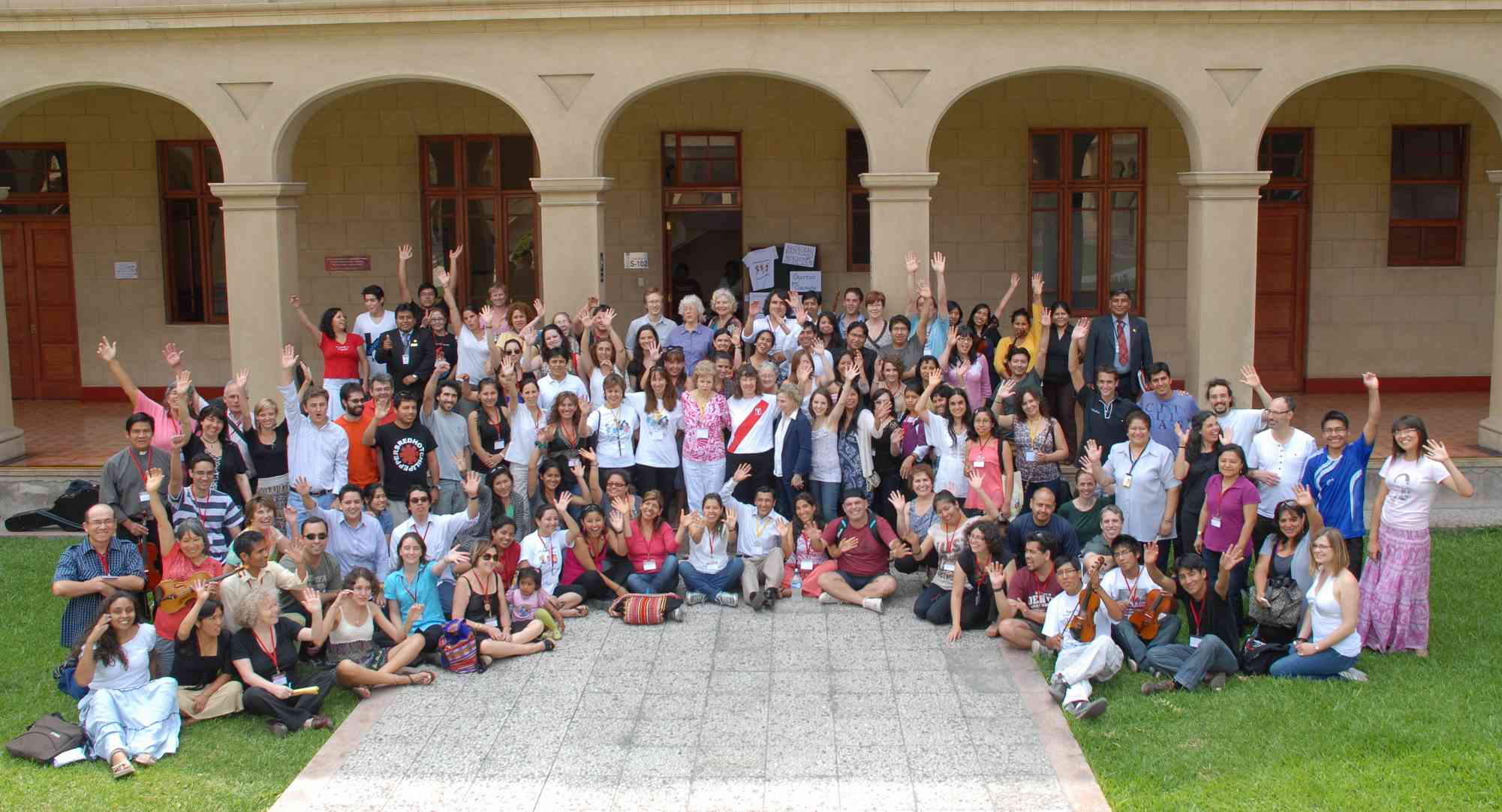
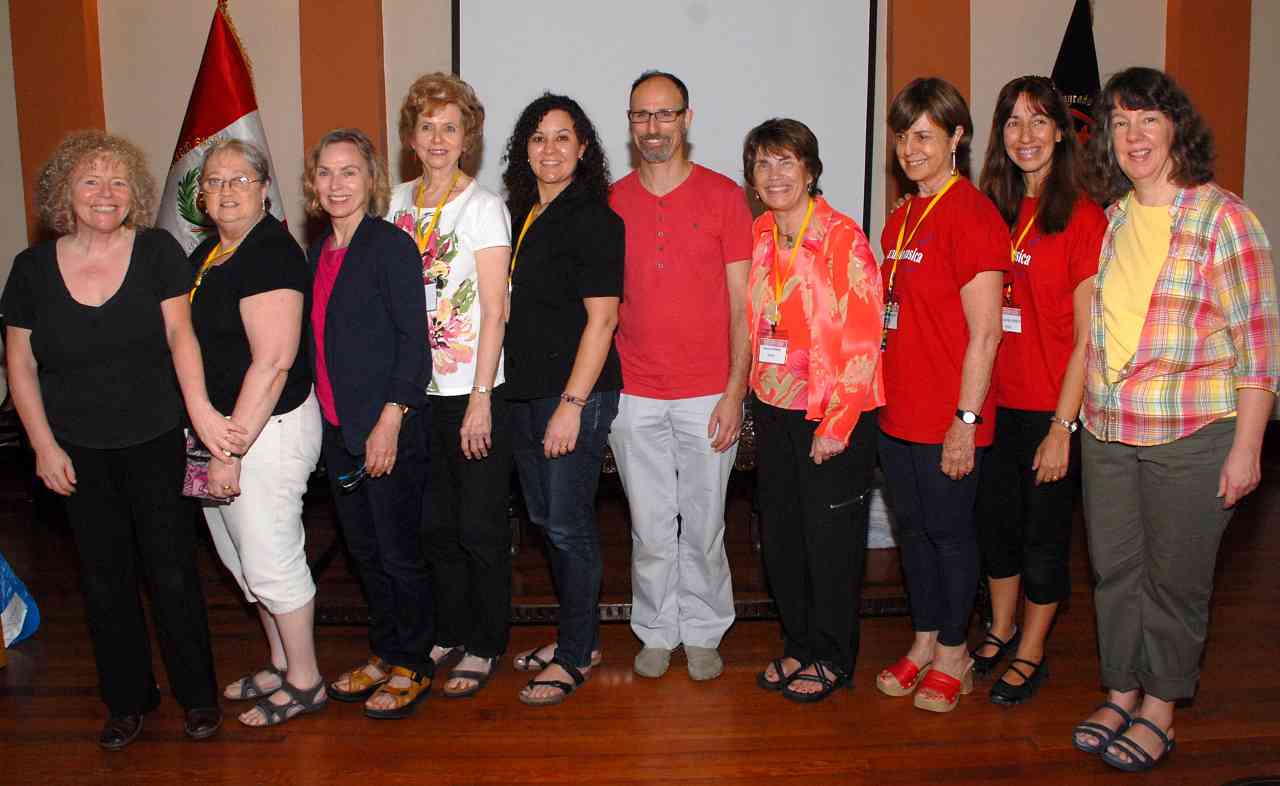
Festival faculty from Chile, Mexico, Bolivia, Peru, USA, and Canada
Translations: Español
The Peru Festival continues to be a vibrant center for Suzuki teacher training in Latin America.
Around 250 teacher participants and 300 students from Argentina, Bolivia, Brazil, Canada, Colombia, Costa Rica, Chile, Ecuador, Guatemala, Mexico, Paraguay, Puerto Rico, Switzerland, USA, Venezuela and all over Peru, including the Andean mountains and the jungle region, gathered together to enjoy music and camaraderie. As well as the usual course offerings in piano, violin, cello, double bass, flute, guitar and recorder, the Peru festival offers attractive courses for the general public: Suzuki philosophy taught by Caroline Fraser USA/Peru, Talent Education and Teaching Music in Elementary Schools both taught by Roberta Centurion, USA/Peru, and Kodaly taught by Lydia Mills, USA/Chile. In addition, more than sixty teachers participated in Early Childhood Music workshops taught by Peruvian teachers Roxana del Barco and Maria Luisa Labarthe who have developed a lively program for babies and toddlers based on the Suzuki philosophy, and incorporating children’s songs and rhymes from Latin America.
Many thanks to SAA teacher trainers Virginia Dixon, Mary Halverson Waldo, Nancy Lokken, Mary Craig Powell, MaryLou Roberts (USA); David Evenchick, Kelly Williamson (Canada); and Fernando Piñero (Argentina) for their generosity of spirit, dedication and flexibility!
Piano Book One and Two with Caroline Fraser:
Teaching Strategies: Learning to Teach by Teaching
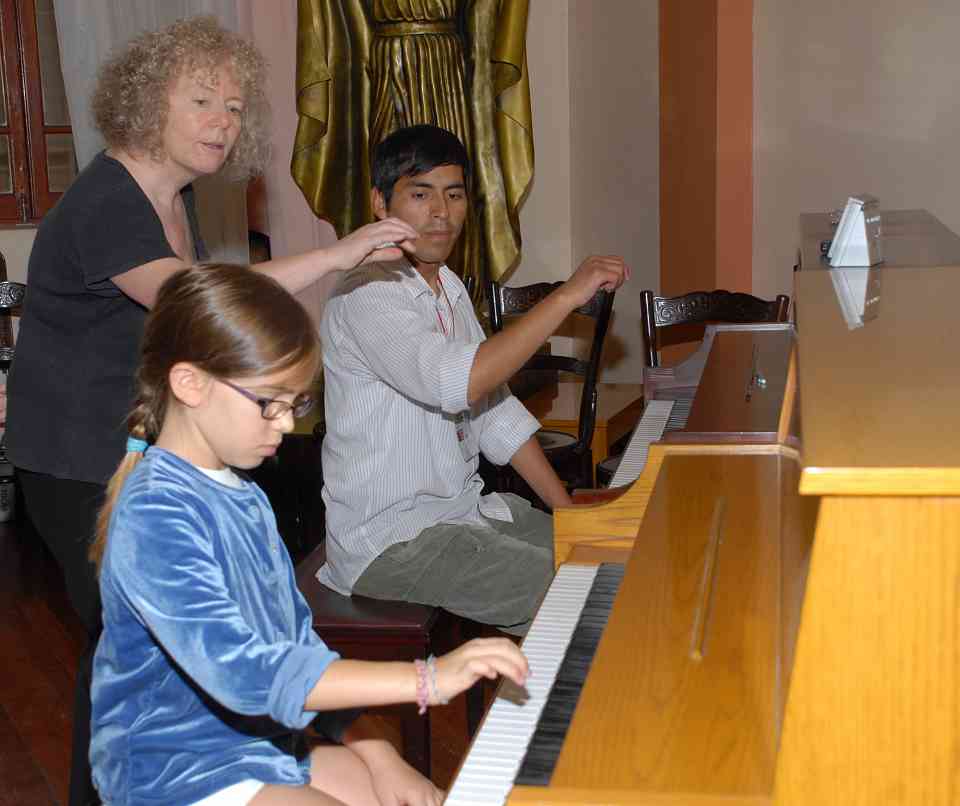
Reuben in a Teaching Strategies course with Caroline Fraser
Teacher training courses in Peru from Book Two onwards have included a teaching practice segment called “Teaching Strategies.” This course is similar to a practicum, giving the participants the opportunity to teach and receive constructive feedback. An innovation this year was to add a shorter Teaching Strategies to the Book One course to support those who plan to teach right away or are already teaching. Each teacher trainer decided on how to design this new part of the Book One course.
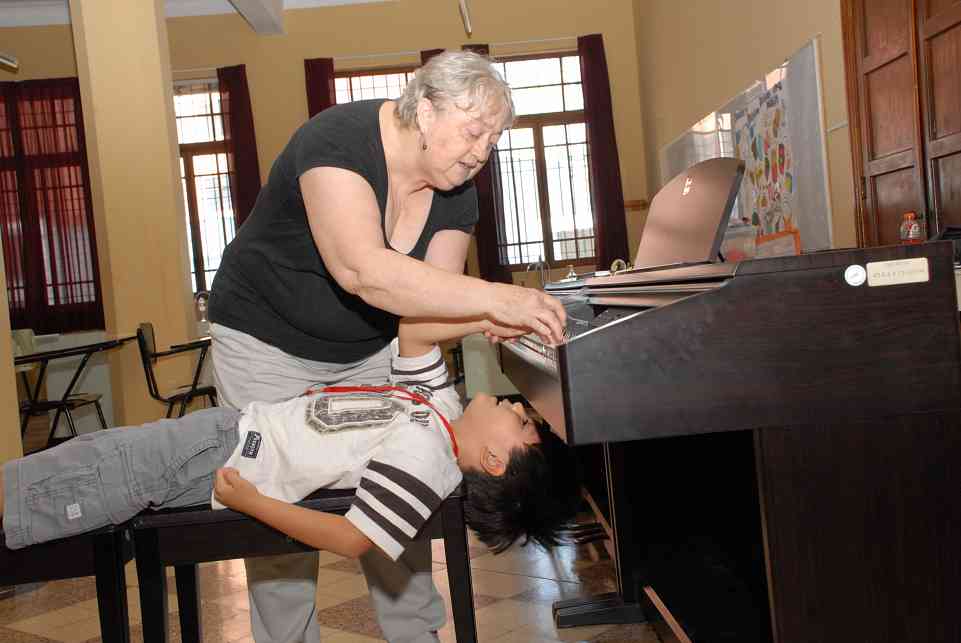
Roberta and upside down student
In the teaching practice for Piano Book One, all the participants had the chance to give an on-site lesson. Some of the concepts which came up in their teaching segment were: how to “insist” on being ready, how to listen to your tone, when to move on, how to smile, how to teach with fewer words, how to encourage the spirit of “serious play,” how to focus on the teaching point, how to give an introduction at the tempo you want. Instead of letting the participant teach and then giving my feedback, I gently intervened and guided the participant in a preventive manner. It was like “side by side” teaching. We discussed what the student knew and what could be worked on: I was there to encourage when things were going well and to lend a hand when I saw the need. Participants always ask me what to do with very active children who do not follow directions easily. We had a wonderful opportunity in Teaching Strategies to address that question. Little five-year-old Juan was being very playful, doing what he wanted and not what the teacher Nayelli was showing him. I crouched down on the other side of Juan and indicated to Nayelli that we should change places. I then connected with Juan’s playful spirit, challenging each finger to be ready and wait before playing. Juan joyfully joined my game and Nayelli was very happy about her experience.
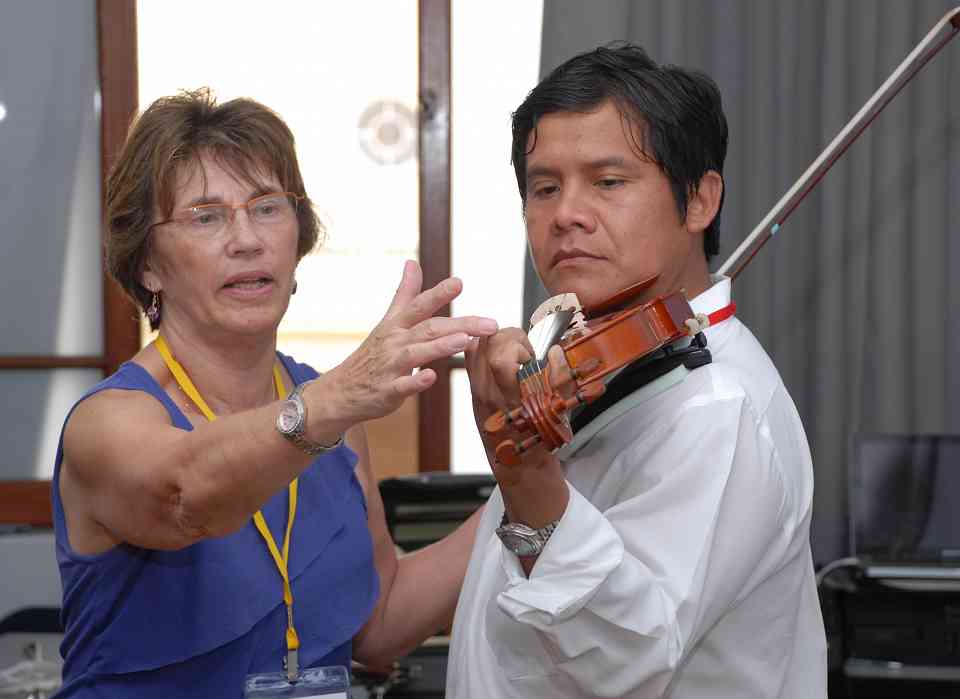
Nancy Lokken and Peruvian teacher
In my Teaching Strategies class connected with the Book Two course, the teaching practice happened at the end of course, and the participants had brought DVDs, and on-site students. I was very pleased with their perceptive self-criticism, having the course freshly in their thoughts. They said such things as “I talked too much,” “I should have given more examples.” Because I was seeing the whole lesson, I could help with pacing: how to manage the time in order to hear a wide repertoire of pieces. The participants discovered that the technical points they were working on should be mastered first in the variations.
All these points are mentioned in the unit courses, but talking about concepts is not the same as putting them into practice or discovering them for oneself. Topics grow out of the participants’ needs, not out of the teacher trainer’s perception of what they need. I see this course as a measure of my ability to train teachers, learning how and where I need to improve my teacher training in order to ensure effective, nurturing teaching on the part of the participants. In my opinion the opportunities this course provides are essential.
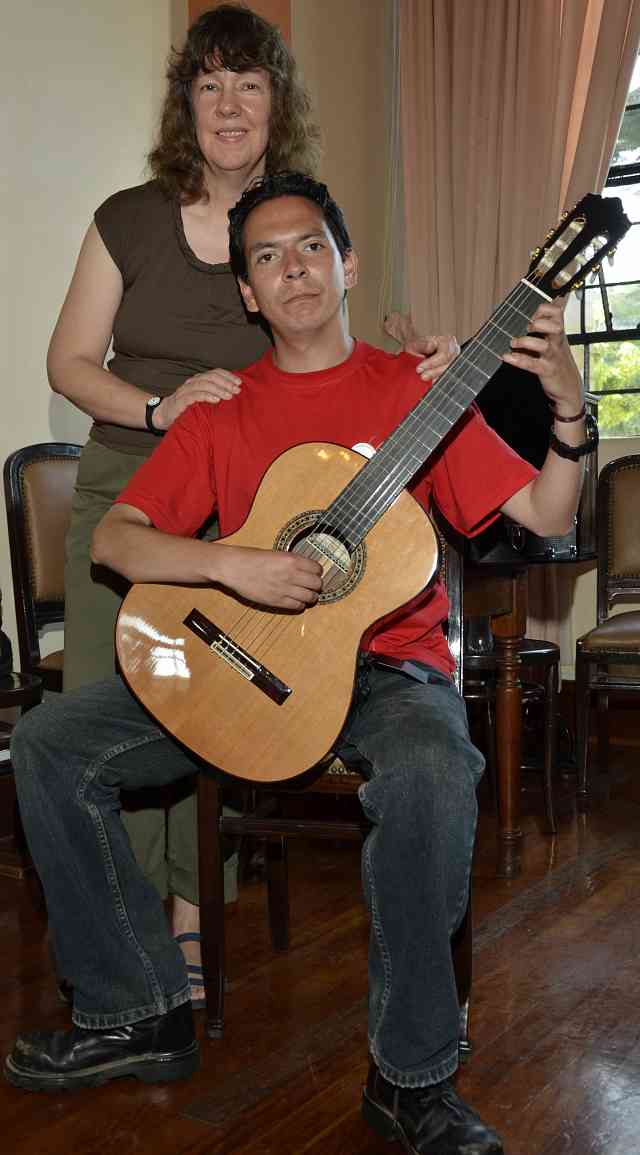
MaryLou Roberts and teacher David with donated guitar
MaryLou Roberts writes about the guitar teacher training:
Practice Teaching a Little at a Time
Teaching Strategies in Book Two and beyond consists of two days of observing trainees teaching. It occurs at the end of each course. The other teachers in the class use the SAA Descriptors to give positive feedback and hone their own positive commenting skills. The teacher trainer then points out helpful ways to be more effective and helps give direction based on the needs of the teacher. Everyone learns something new each time. This really helps teachers apply what has been learned in all previous courses, and it keeps their teaching fresh and growing. Teachers can bring a recording of a lesson or group class. The videos offer more opportunity to observe, for example, body language, which is very difficult to include in written training materials.
This was the first year Teaching Strategies was included in the Book One courses. Practice teaching was done with peers and children. Most practice teaching was done in Pre-Twinkle. One teacher was the parent, so we could practice including the parent in specific points and assignments. Just going through the motions verified understanding of some very basic points, such as limiting the number of ideas taught, including repetition, demonstrating more and not talking too much, or covering too much material, following through on a lesson point, summarizing the lesson point and giving the assignment.
Each teacher learned a different point, and as we went through the class, the lessons became more positive, concise, and effective. It is impossible to guess what each teacher is going to need to be effective, and most Book One trainees will begin teaching within the first year after taking a course. So there were many problems that were solved before they even began with their first student.
After practice teaching, each teacher felt more confident that they knew what to do and how to give a good lesson. Teachers who are successful with children right away will have momentum and enthusiasm to pursue more training. This early success in teaching is so important to our goals.
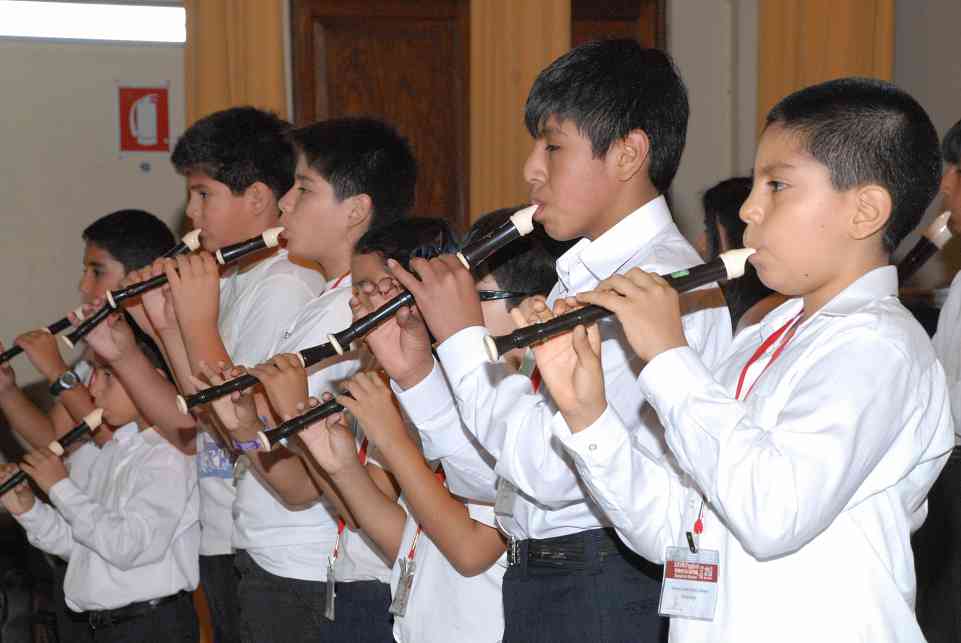
Recorder students

Double bass participants from Peru
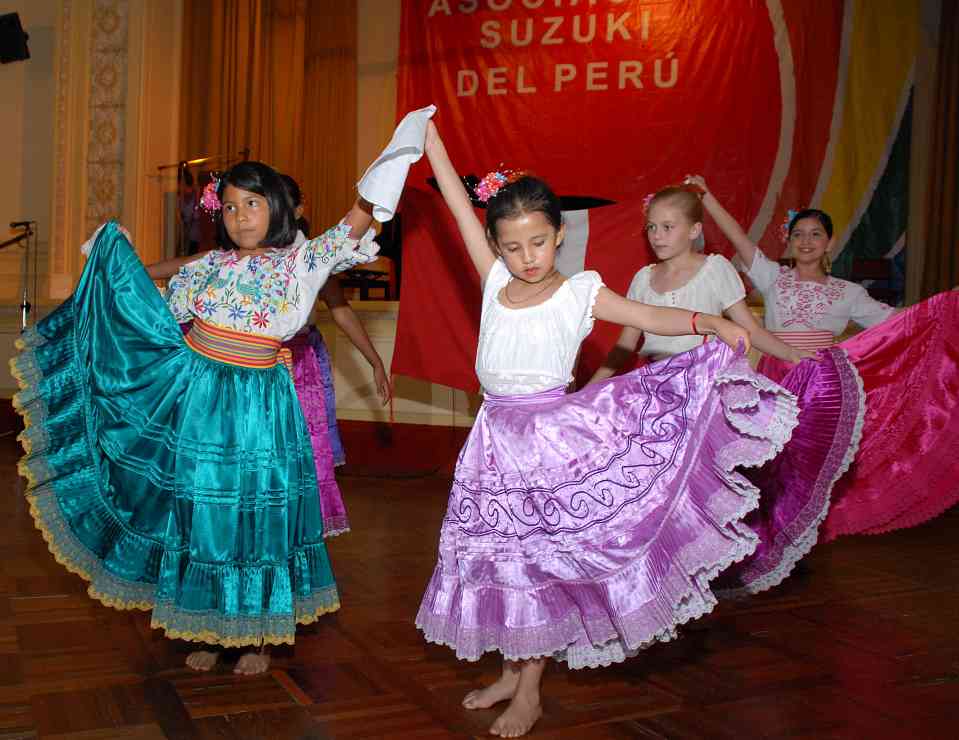
Dance workshop
Kelly Williamson writes about the flute teacher training:
Book One Teaching Strategies Class
We started by discussing the importance of having a clear vision of your desired outcomes for each student, including immediate, short-, and long-term goals. That morning the teachers had observed a video compilation of student performances at various ages and levels. They also observed a section of a lesson where a late-Book Two student was working on a new piece. The difference between the Book Two student’s tone quality in the new piece, and the other students’ tone playing their polished pieces, was noted. We then reviewed the performance descriptors, again comparing the differences between the polished performances and the working-level piece. These observations helped to focus all of our attention on what a finished piece should look and sound like, which in turn helps us as teachers to decide what to work on with a student in their lesson.
The teachers reviewed the lesson sequence outline and the pedagogy descriptors, observing that the outline describes the process and sequence of events in the lesson, and the descriptors refer to how the communication takes place between teacher and student. With the assistance of Fernanda de Castro of Brazil, who was studying Book Four and had already participated in the Book Two and Three strategies courses, I taught a short sample lesson, asking the teachers to use the pedagogy descriptors to describe what took place in the lesson. I was careful to demonstrate certain descriptors and not others, while maintaining a pleasant and positive tone to the overall lesson. Afterwards we discussed which of the descriptors had been applicable in the lesson, and which were applicable, but in the negative—the objectivity of the process being emphasized throughout.
After this, the teachers each had an opportunity to teach a short lesson to one of their colleagues while we all observed and took notes. At the end of each lesson, the teacher first commented on his or her own work, using the lesson sequence document and also the pedagogy descriptors. I gave some feedback on their observations, and then their colleagues offered further positive feedback using the descriptors. The teachers were very detailed in their evaluation of their own work—and sometimes quite severe on themselves! One person was invited to teach another lesson based on his own criticism and on the feedback he’d received, with the challenge of teaching a lesson without using words. As the teachers became more familiar with the process, we also discussed related topics such as choice of words, use of space, and body language. I was pleased to observe the teachers’ sensitivity and honesty in their communications with their colleagues, both when they were acting as their students, and when they were speaking as peers. All were enthusiastic about the value of the exercise, and in their praise of their colleagues’ efforts.

Anna Wiesner in Teaching Strategies
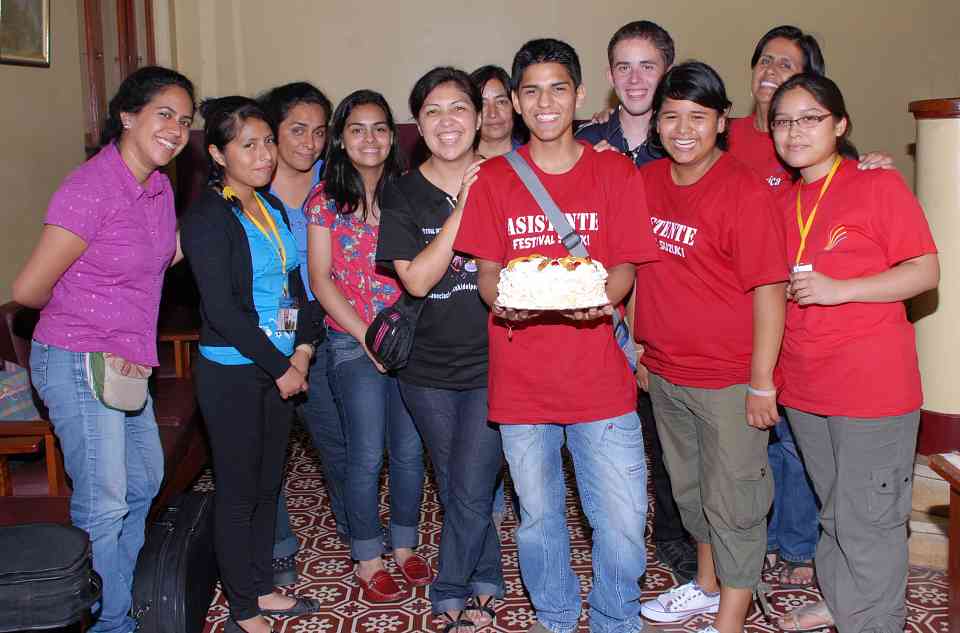
Festival Support Team
Cello teacher training participants from David Evenchick’s class wrote:
“Teaching Strategies is a great idea. I liked that we learned how to structure a class. After the theoretical part of the course, I could use my knowledge to put into practice what I had learned, and it was not easy. It helped me a lot that behind my student was the board with the steps which I had to follow. These written points were very important. I could almost do it correctly.”
–Anna Wiesner, Chile
“Although it is not something easy to do, I think the Teaching Strategies course is a big part of the course for teacher training. It is hard to try and teach in a situation where you don’t know the student. Everyone is watching you, and you have just started to understand how this Suzuki teaching works. On the other hand, it gives you a chance to put things into practice straight away and receive feedback on the spot. It is also important to be able to watch other teachers, people that you have spent a good amount of time with and have shared some wonderful moments during the course. It is really good to watch their lessons and learn with them. Everyone has a special way of doing things so it is a great experience to learn from each other. After all, this is what Suzuki is all about: to be able to work in community and learn from each other.”
–Monica Lima, Brazil
Future events to be held in Lima, Peru: ¡Nos vemos aquí!
- XXIX International Suzuki Festival, January 5–28, 2014
- VI Encuentro de Profesores de América Latina, January 11–13, 2014
- I Encuentro de Estimulación Musical Temprana de América Latina, January 11–13, 2014
- XXX International Suzuki Festival, January 2015
- III Encuentro de Alumnos Suzuki de América Latina, January 2015
Más información: www.asociacionsuzukidelperu.com
Contactar: [javascript protected email address]
Many thanks to everyone who has donated time, donated instruments, and made financial contributions to the festival in Peru. A special thank you goes to the SAA office and SAA members for the generous support that makes the Peru Festival possible. Thanks also to Colegio Sagrado Corazón Sophianum for the use of its beautiful facilities and to the American Embassy in Peru.
Cecilia Calvelo, thank you for your unconditional dedication to Suzuki in Latin America. Muchísimas gracias!


Festival faculty from Chile, Mexico, Bolivia, Peru, USA, and Canada
XXVIII Festival Internacional de Lima, Perú, Enero 5 al 28, 2013
Compilado y escrito por Caroline Fraser
Traducción Cecilia Calvelo-Hopkins
El Festival Internacional del Perú continúa siendo un centro vibrante de entrenamiento de profesores Suzuki en toda Latinoamérica. Alrededor de 250 maestros y más de 300 alumnos de Argentina, Bolivia, Brasil, Canadá, Colombia, Costa Rica, Chile, Ecuador, Guatemala, México, Paraguay, Puerto Rico, Suiza, USA, Venezuela y Perú (incluyendo la región Andina y la zona selvática de este último) se reunieron en nuestro festival para disfrutar de la música y de la amistad musical que los une. Además de los típicos cursos de capacitación en violín, piano, cello, contrabajo, guitarra, flauta dulce, y flauta traversa, el festival del Perú ofrece también cursos para el público en general, como el curso de Filosofía Suzuki a cargo de Caroline Fraser, USA/Perú, Educación del Talento y Educación musical en las escuelas primarias a cargo de Roberta Centurion, USA/Perú, y el curso de Kodaly a cargo de Lydia Mills, USA/Chile. Asimismo, más de 60 profesores participaron en los talleres de Estimulación Musical Temprana impartidos por las profesoras peruanas Roxana del Barco y Maria Luisa Labarthe quienes han desarrollado un programa alegre y creativo para bebes y niños de hasta 5 años basado en la filosofía Suzuki y utilizando un repertorio de cancionero infantil de toda Latinoamérica.
Muchas gracias a los profesores TT Virginia Dixon, Mary Halverson, Nancy Lokken, MaryCraig Powell, MaryLou Roberts (USA); David Evenchick, Kelly Williamson (Canadá) y Fernando Piñero (Argentina) por su fuerza de espíritu, dedicación y flexibilidad.
Estrategias de la Enseñanza: Aprendiendo a Enseñar mientras enseñamos

Reuben in a Teaching Strategies course with Caroline Fraser
Los cursos de capacitación para profesores en Perú incluyen desde el Libro 2 en adelante, un segmento de práctica docente que se llama Estrategias de la Enseñanza que se imparte al final de cada Libro cursado. Este curso, muy similar a un Practicum, brinda la oportunidad a sus participantes de enseñar y recibir feedback constructivo sobre la tarea docente realizada. Una innovación que hemos implementado este año fue agregar una versión más breve de este curso para los profesores cursando Libro 1. Cada maestro capacitador fue responsable en diseñar y decidir cómo implementar esta nueva adición al curso dicho Libro.

Roberta and upside down student
En esta parte de Estrategias de la Enseñanza del Libro 1 de Piano, todos los participantes tuvieron la oportunidad de dar clase a alumnos del Festival. Algunos de los conceptos que surgieron en esta clase fueron: Como insistir en estar “listos”) o preparación previa a la ejecución), como escuchar y estar pendientes del sonido que producimos, cuando seguir adelante y cuando detenernos en algún punto problemático, como sonreír de una manera amena, como enseñar hablando menos, como concentrarnos en lo que es esencialmente importante, como fomentar el tocar “en serio”, como dar las entradas a un tempo apropiado, etc.
En vez de dejar que los participantes dieran clase y luego dar mi feedback, decidí intervenir cuidadosamente guiando al participante de una forma preventiva. Fue como dar clase “codo a codo”. Hablamos de lo que el alumno ya sabia y aquello que necesitaba aún más trabajo. Mi rol era estar ahí alentándolos cuando todo iba bien, o dar una mano si hacía falta. Los participantes siempre preguntan qué hacer con alumnos activos que no siguen dócilmente las instrucciones del maestro. Tuvimos la maravillosa oportunidad en Estrategias de la Enseñanza de abordar esta cuestión. El pequeño Juan, de 5 años, se portaba de una manera juguetona haciendo todo lo que el quería y no lo que la Profesora Nayelli le estaba indicando. Me agache entonces al otro lado de Juan y le dije a Nayelli que debíamos cambiar lugares, tomando yo la posición de profesora. De esa manera pude conectarme con el espíritu juguetón de Juan y hacer un juego donde desafié a sus deditos a prepararse y esperar antes de tocar. Juan participó del juego con alegría y Nayelli quedó muy satisfecha con la experiencia.

Nancy Lokken and Peruvian teacher
En Estrategias de la Enseñanza del Libro 2, la porción de práctica docente ocurrió al final del curso y los participantes habían traído grabaciones en DVDs y también dieron clase a alumnos del Festival. Quede muy satisfecha con la autocrítica de los profesores teniendo en cuenta que el material del curso estaba tan fresco en sus mentes. Decían cosas como: “hable mucho”, “tendría que haber dado más ejemplos”. Como yo estaba viendo las clases enteras, podía ayudar con el paso de la clase y dar ideas para manejar el tiempo de forma tal que el profesor pueda escuchar varias piezas. Los participantes descubrieron que los puntos técnicos en los que estaban trabajando deberían haber sido dominados ya en las variaciones.
Se sabe que todos estos aspectos se mencionan en los cursos de cada libro, pero hablar de conceptos no es lo mismo que ponerlos en práctica o descubrirlos por uno mismo. Dichos temas van surgiendo a través de la experiencia y necesidad de cada docente, y no de la percepción que tenga el TT de lo que dichos docentes van a necesitar. Yo pienso que este curso mide mi habilidad de entrenar profesores, y me brinda la oportunidad de mejorar la manera en que los entreno asegurándome de que se van a sus escuelas o estudios con herramientas de trabajo efectivas y útiles para cada uno de ellos. En mi opinión este curso es esencial.

MaryLou Roberts and teacher David with donated guitar
MaryLou Roberts escribe sus opiniones acerca de los cursos de guitarra:
Practicando a dar clase poquito a poco**
Estrategias de la Enseñanza, a partir del Libro 2, consiste en una clase en la que observamos a los profesores participantes dar clase durante 2 días. Se imparte al final de cada curso. Los demás profesores de la clase usan los Descriptores de la SAA para dar feedback y perfeccionar así su propia habilidad de comentar en forma constructiva. El TT señala maneras de ser más efectivos, y guía al profesor basado en las necesidades que este mismo exhibe. Todos aprendemos algo nuevo! Esto ayuda a los profesores a aplicar de hecho lo que han aprendido en los cursos de capacitación y mantiene su docencia fresca y actualizada. Los profesores pueden traer grabaciones de clases grupales o privadas. A través de los videos podemos apreciar cosas como el lenguaje corporal lo cual es tan difícil ejemplificar en asignaturas escritas.
Este fue el primer año que se ofreció Estrategias de la Enseñanza en el curso del Libro 1. Estas prácticas docentes se practicaron con pares y alumnos del festival. En su mayoría utilizamos repertorio y actividades de Pre-Twinkle. Un profesor representaba al padre para poder practicar de esa forma cosas específicas que se refieren a esta figura del triángulo Suzuki. Al representar la clase, pudimos verificar el entendimiento de cosas tan básicas como el limitar el número de ideas que se presentan en una clase, la inclusión de la repetición como herramienta básica de trabajo, demostrar mas y hablar menos, no cubrir mucho material, el seguimiento de un punto clave, el resumen de la clase, y asignar la tarea.
Cada profesor aprendió algo diferente de esta experiencia, y conforme iba pasando el curso las clases fueron siendo cada vez más positivas, concisas, y efectivas. Es imposible adivinar lo que cada profesor va a necesitar para ser más eficaz, y en su mayoría estos profesores que cursan Libro 1 van a estar dando clase dentro del primer año después de haber cursado el primer nivel de capacitación. Por lo tanto pudimos resolver problemas antes de que sucedieran con los primeros alumnos.
Después de practicar como dar clase cada profesor se sintió más seguro en sí mismo, puesto que sabía mejor que hacer y cómo dar una buena clase. Este éxito inicial es muy importante para alcanzar nuestras metas y para de este modo formar maestros que tengan éxito con sus alumnos inmediatamente apenas empiezan a trabajar. Ellos querrán volver a aprender más sobre la docencia si tienen éxito desde un comienzo temprano.

Recorder students

Double bass participants from Peru

Dance workshop
Kelly Williamson escribe acerca de los cursos de capacitación de flauta:
Estrategias de la Enseñanza Libro 1
Nosotros comenzamos por hablar acerca de la importancia de tener una visión clara y metas concretas a corto, mediano, y largo plazo para cada alumno. En la mañana los profesores habían visto un video de una compilación de alumnos de distintas edades tocando flauta en varios niveles diferentes. También en ese video habían visto a un alumno de final de Libro 2 estudiando una pieza nueva. La diferencia entre el sonido que producía el alumno estudiando la pieza nueva y el sonido de los alumnos tocando piezas pulidas y bien trabajadas, se notaba. Entonces repasamos los descriptores pedagógicos comparando la diferencia entre las obras ya pulidas y las obras que aun el alumno no domina bien, o sea las piezas que están en estudio. Estas observaciones nos sirvieron para concentrarnos en como una pieza trabajada y pulida tiene que sonar y como se ve ese alumno tocando esa pieza ya bien estudiada, lo cual a su vez ayuda a los profesores a decidir en que trabajar o en que centrar la atención a la hora de dar la clase.
Los profesores repasaron las secuencias del esquema de clase tal como se detalla en los descriptores pedagógicos, observando que el perfil general se refiere al proceso y secuencia de eventos durante la clase, y los descriptores se refieren a la comunicación entre profesor y alumno. Con ayuda de Fernanda De Castro, procedente de Brasil, quien estaba estudiando el Libro 4 y había ya participado en Estrategias de la Enseñanza de los Libros 2 y 3, di una corta clase demostrativa pidiendo a los demás profesores que, usando los descriptores pedagógicos, describieran que iba pasando en la clase. Tome la precaución de demostrar solo algunos de ellos manteniendo un tono positivo y placentero a través de la clase. Luego, hablamos de cuales habían sido los descriptores utilizados y cuales habían estado ausentes, o presentes en el sentido opuesto al descrito pedagógicamente, siempre haciendo hincapié en la objetividad del proceso.
Después de esa experiencia los profesores tuvieron que dar clase a un colega mientras todos los demás observábamos y tomábamos nota de que lo iban haciendo. Al final de cada lección los profesores tenían que comentar sobre el trabajo que acababan de hacer usando la secuencia de la clase y los descriptores pedagógicos. Yo daba mi opinión acerca de las observaciones y luego los demás profesores iban haciendo lo mismo, siempre usando los descriptores. Todos los profesores fueron autocríticos con uso de detalles en su autoevaluación y en algunos casos muy severos consigo mismos! A uno de ellos lo invitamos a dar otra clase basándose en su propia autocritica y en el feedback recibido de sus compañeros, con el agregado de dar dicha clase sin hablar! A medida que los profesores se fueron familiarizando con este proceso, comenzamos a hablar de otras cosas relacionadas como el uso de lenguaje apropiado, y el uso del espacio y también los gestos o lenguaje corporal. Quede muy satisfecha con el cuidado con que los profesores ofrecían comentarios a sus colegas en una manera honesta y respetuosa, tanto cuando estaban en el rol de alumno o desde el punto de vista de otro colega par. Todos fueron muy entusiastas acerca del valor de este ejercicio y en los elogios para con el esfuerzo realizado por cada uno.

Anna Wiesner in Teaching Strategies

Festival Support Team
Profesores de Cello, participantes de la clase de David Evenchick, escribieron:
“El curso de Estrategias de la Enseñanza es una gran idea. Me gusto que en este curso aprendimos a estructurar la clase. Después de la parte teórica pudimos poner en práctica lo aprendido, y eso no fue fácil! Me ayudó mucho que detrás del alumno estaban escritos en la pizarra los pasos a seguir. Estos puntos claramente escritos fueron muy importantes para mí. Casi logro que me salga todo bien!”
—Anna Wiesner, Chile
“A pesar de que el curso de Estrategias no es algo fácil, creo que el curso en sí es gran parte de nuestro entrenamiento como profesores. Es difícil dar clase a un alumno que uno no conoce, todos te están mirando, y tu estas apenas empezando a entender cómo funciona el método Suzuki. Pero, por otra parte, te da la oportunidad de poner en práctica lo aprendido y recibir feedback de inmediato. También es importante el hecho de que en este curso puedes ver a otros profesores dando clase, profesores con quienes uno ha compartido el curso y pasado magníficos momentos. Es muy bueno verlos a ellos dar clase y aprender a su lado. Cada uno tiene su manera de hacer las cosas y por eso es muy enriquecedor aprender los unos de los otros. Al final de todo, esto es de lo que el método Suzuki se trata: trabajar juntos en comunidad aprendiendo en conjunto.”
—Monica Lima, Brasil
Próximos Eventos en Lima, Perú: ¡Nos vemos allí!
- XXIX Festival Internacional Suzuki, January 5-28, 2014
- VI Encuentro de Profesores de América Latina, Enero 11-13, 2014
- I Encuentro de Estimulación Musical Temprana de América Latina, Enero 11-13, 2014
- XXX, Festival Internacional Suzuki, January 2015
- III Encuentro de Alumnos Suzuki de América Latina, Enero 2015
Más información: www.asociacionsuzukidelperu.com
Contactar: [javascript protected email address]
Muchas gracias a todas las personas que han donado su tiempo, instrumentos, o hecho contribuciones económicas al Festival del Perú. Un agradecimiento especial va a la SAA y a los miembros de esta quienes con su generoso apoyo hacen posible nuestro festival. También un especial agradecimiento al Colegio Sagrado Corazón Sophianum por habernos permitido usar su hermoso edificio y también a la Embajada de los Estados Unidos en Perú.
Cecilia Calvelo, gracias por el apoyo y dedicación incondicional al método Suzuki en Latinoamérica. Muchísimas gracias!







